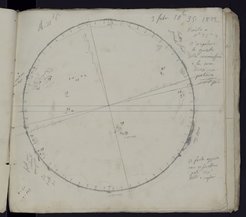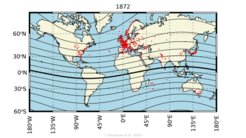Auroras in the Caribbean
The solar storm of February 1872 was exceptionally violent. A recent study provides new insights into the extreme event.
151 years ago, a powerful solar storm hit Earth: on February 4, 1872, telegraph offices in many parts of the world reported hours of disturbances and outages; auroras were visible in India, Sudan and the Caribbean. In the scientific journal The Astrophysical Journal, a group of 22 researchers led by the Nagoya University in Japan and including a scientist from the Max Planck Institute for Solar System Research (MPS) in Germany now presents the most comprehensive investigation of the unusual event to date. The researchers analyzed a large number of historical records, measurements and documents from Europe, Asia, Africa, the USA and Australia - including previously unknown sources. As the study shows, the solar storm of 1872 was one of the three most violent ever observed directly. The team was also for the first time able to identify the region on the Sun that triggered the storm. This can help to understand how such violent solar storms originate – and what signs to look out for.

In violent eruptions, the Sun repeatedly hurls radiation and high-energy, charged particles into space. If they travel in the direction of Earth and hit our planet’s magnetic field, this is called a solar storm. Smaller storms are noticeable as brightly colored auroras at high latitudes; stronger ones can induce such strong electrical currents in the atmosphere and sometimes even near the ground that radio transmissions are impaired and power transformers are destroyed. The most famous example is the Carrington event of 1859, the strongest known solar storm, which caused the telegraph network to collapse in large parts of northern Europe and North America; auroras could be seen even in Rome, Mexico and Cuba.
Researchers assume that today a similarly strong solar storm would have much more far-reaching consequences - not least because today's infrastructure is heavily dependent on satellites, which can also be affected. This makes it all the more urgent to be able to predict severe events of this kind. "Extreme solar storms only occur very, very rarely," explains MPS scientist Dr. Theodosios Chatzistgeros, co-author of the current study. "In principle, this is of course a good thing, but it makes research into these events more difficult," he adds. In order to better understand such storms, scientists therefore have to look to the past.
For example, to the solar storm of February 4, 1872. Similar to the Carrington event, 13 years later the auroras were also visible at unusually low latitudes: a red, blue or violet glow, bright jets and other light phenomena were witnessed in the skies over what is now Mumbai (India), Khartoum (Sudan) and the Caribbean. There are also reports of far-reaching disruptions to telegraph operations. In the current study, researchers compile and evaluate known and newly discovered sources. They not only look at the extraordinary events that unfolded on Earth on February 4, 1872, but also at the events on the Sun in the days before.
Regular sketches of the Sun

In the late 19th century, regular observations of the Sun were part of everyday scientific life at several observatories, for example in the Italian cities of Rome, Palermo and Moncalieri. The astronomers there were familiar with the approximately eleven-year sunspot cycle, carefully recorded the number, size, shape and lay-out of the dark areas on the solar surface and were sometimes also able to observe eruptions. Their sketches and entries provided the authors of the current study with crucial information. For example, the Jesuit priest Angelo Secchi, director of the Vatican Observatory, made detailed hand drawings of the sunspots in the days before the solar storm.
"Today we know that sunspots are associated with strong magnetic fields on the visible surface of the Sun. They are often the starting point of solar eruptions," explains Chatzistergos. The drawings by Secchi and other contemporaries from the last days of January and the first days of February 1872 show a sharp increase in the number of sunspots. The research team was able to identify a group of sunspots that must have triggered the solar storm. The time and place of its occurrence fit exactly. At first glance, the collection of dark spots appears rather unspectacular: Neither their overall size nor the dimensions of the individual spots are extraordinary. However, the arrangement of the spots within the group does not follow typical regularities. According to Chatzistergos, the magnetic field architecture indicated by this arrangement has the potential to release a large amount of energy.
Auroras in the Tropics

The consequences of the eruption were soon felt on Earth. On February 4, 1872, routine measurements of the Earth's magnetic field from Greenwich (England), Tbilisi (Georgia) and Mumbai (India), among others, announced the onset of the storm. The data allows the researchers to narrow down the extent to which the storm must have weakened the Earth's magnetic field. Maybe even more impressive are the numerous sightings of auroras. The research team analyzed reports in newspapers, chronicles and scientific journals, as well as drawings, diary and ship log entries from Asia, Europe, Africa, Australia and America. Some of these sources were previously unknown. The auroral sightings closest to the equator were found in Tobago in the Caribbean, just 11 degrees north of the equator.
Overall, this provides a comprehensive picture of the extreme solar storm: alongside the Carrington event of 1859 and another storm in 1921, the solar storm of 1872 is therefore one of the three most violent events known to date. Not since the beginning of the space age has such a strong storm occurred.
Solar activity is increasing
The Sun is currently going through what is known as its 25th solar cycle and is approaching its next maximum, which it is expected within the next year. The associated more frequent and stronger solar storms have already made themselves felt in Germany and even parts of southern Europe; the recent auroras were visible even in parts of Greece and Italy. However, extreme solar storms such as the Carrington event and the now studied storm in 1872 are rather infrequent – even in times on increasing solar activity. Further research in past geomagnetic storms is needed to better understand such events for the future.


